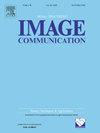Cut-FUNQUE: An objective quality model for compressed tone-mapped High Dynamic Range videos
IF 2.7
3区 工程技术
Q2 ENGINEERING, ELECTRICAL & ELECTRONIC
引用次数: 0
Abstract
High Dynamic Range (HDR) videos have enjoyed a surge in popularity in recent years due to their ability to represent a wider range of contrast and color than Standard Dynamic Range (SDR) videos. Although HDR video capture has seen increasing popularity because of recent flagship mobile phones such as Apple iPhones, Google Pixels, and Samsung Galaxy phones, a broad swath of consumers still utilize legacy SDR displays that are unable to display HDR videos. As a result, HDR videos must be processed, i.e., tone-mapped, before streaming to a large section of SDR-capable video consumers. However, server-side tone-mapping involves automating decisions regarding the choices of tone-mapping operators (TMOs) and their parameters to yield high-fidelity outputs. Moreover, these choices must be balanced against the effects of lossy compression, which is ubiquitous in streaming scenarios. In this work, we develop a novel, efficient model of objective video quality named Cut-FUNQUE that is able to accurately predict the visual quality of tone-mapped and compressed HDR videos. Finally, we evaluate Cut-FUNQUE on a large-scale crowdsourced database of such videos and show that it achieves state-of-the-art accuracy.
Cut-FUNQUE:用于压缩音调映射高动态范围视频的客观质量模型
近年来,高动态范围(HDR)视频因其比标准动态范围(SDR)视频具有更大的对比度和色彩范围而大受欢迎。尽管由于苹果iphone、谷歌Pixels和三星Galaxy手机等最近的旗舰手机,HDR视频捕捉越来越受欢迎,但仍有大量消费者使用无法显示HDR视频的传统SDR显示器。因此,HDR视频必须经过处理,即色调映射,然后才能传输给大部分支持sdr的视频消费者。然而,服务器端色调映射涉及到自动化有关色调映射操作符(tmo)及其参数选择的决策,以产生高保真输出。此外,这些选择必须与有损压缩的影响相平衡,有损压缩在流场景中无处不在。在这项工作中,我们开发了一种新的、有效的客观视频质量模型Cut-FUNQUE,它能够准确地预测色调映射和压缩HDR视频的视觉质量。最后,我们在此类视频的大规模众包数据库上评估Cut-FUNQUE,并表明它达到了最先进的精度。
本文章由计算机程序翻译,如有差异,请以英文原文为准。
求助全文
约1分钟内获得全文
求助全文
来源期刊

Signal Processing-Image Communication
工程技术-工程:电子与电气
CiteScore
8.40
自引率
2.90%
发文量
138
审稿时长
5.2 months
期刊介绍:
Signal Processing: Image Communication is an international journal for the development of the theory and practice of image communication. Its primary objectives are the following:
To present a forum for the advancement of theory and practice of image communication.
To stimulate cross-fertilization between areas similar in nature which have traditionally been separated, for example, various aspects of visual communications and information systems.
To contribute to a rapid information exchange between the industrial and academic environments.
The editorial policy and the technical content of the journal are the responsibility of the Editor-in-Chief, the Area Editors and the Advisory Editors. The Journal is self-supporting from subscription income and contains a minimum amount of advertisements. Advertisements are subject to the prior approval of the Editor-in-Chief. The journal welcomes contributions from every country in the world.
Signal Processing: Image Communication publishes articles relating to aspects of the design, implementation and use of image communication systems. The journal features original research work, tutorial and review articles, and accounts of practical developments.
Subjects of interest include image/video coding, 3D video representations and compression, 3D graphics and animation compression, HDTV and 3DTV systems, video adaptation, video over IP, peer-to-peer video networking, interactive visual communication, multi-user video conferencing, wireless video broadcasting and communication, visual surveillance, 2D and 3D image/video quality measures, pre/post processing, video restoration and super-resolution, multi-camera video analysis, motion analysis, content-based image/video indexing and retrieval, face and gesture processing, video synthesis, 2D and 3D image/video acquisition and display technologies, architectures for image/video processing and communication.
 求助内容:
求助内容: 应助结果提醒方式:
应助结果提醒方式:


